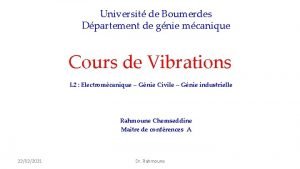Fluid Structure Interactions FSI Research Group Investigation of

- Slides: 1

Fluid Structure Interactions (FSI) Research Group Investigation of wall-bounded turbulence over sparsely distributed roughness M. Placidi, B. Ganapathisubramani and M. Tan Faculty of Engineering and the Environment mp 1 r 10@soton. ac. uk Background Experimental Facilities and Method • Sparse distribution of surface roughness is found in abundance in natural environments and in a variety of engineering applications. • Barnacle growth on ship’s hull (Figures 1 and 2) and Atmospheric Boundary Layer (Figure 3) are classical examples. 3 x 2 Wind tunnel • 0. 9 x 1. 35 x 4. 5 m long test section • Velocity range = 0. 1 – 25 m/s • Slightly favorable pressure gradient • PIV “friendly” Figure 2: Maintenance of ship hull in situ. Ship. Hull. Performance. org. Lego® Elements • cylindrical and rectangular 2 x 2 bricks • Staggered arrays Figure 6: Experimental set up Figure 1: Accumulation of marine growth (barnacles) on the ship’s hull. © 2009 Igor Sterzhantov. Experimental Technique Particle Image Velocimetry (PIV) Figure 3: Urban boundary layers and turbulence in the urban canopy. Princeton University. • PIV is based on the measurement of the displacement of small tracer particles, that are released into the fluid; Roughness Characterization • The tracer particles are illuminated within a thin light sheet generated from a pulsed light source; • Jimenez (2004) pointed out that while boundary layers over surfaces with a dense distribution of roughness elements have been the object of numerous studies, the effects of sparse roughness has been poorly investigated (Figure 4). Figure 4: Equivalent sand roughness for various surfaces versus the frontal solidity. Jimenez (2004). • the light scattered by the particles is recorded onto two subsequent image frames by a CCD camera; • Cross-correlating the particle-image patterns in small interrogation windows, between the first and second image frame, allows the evaluation of the displacement hence, the local fluid velocity. Figure 5: Frontal and Plan Solidity. Grimmond and Oke (1998). Regular roughness can be characterized using two parameters: Figure 7: Schematic of a typical PIV measurements system. Scarano 2010 1. Frontal Solidity λF=AF/AT (which is the ratio of the total projected frontal area of the roughness per unit wall parallel area); 2. Plan Solidity λP=AP/AT (which is the ratio of the total plan area of the roughness per unit wall parallel area). Figure 8: Classical PIV image. Streamwise (x, y) plane. Colorbar shows mean streamwise velocity U. Future Work Townsend’s Similarity Hypothesis • Analyzing the effect of urban-like roughness on the turbulence structure; • Townsend (1976) stated that the turbulence structure is unaffected by the surface condition, at sufficient distance from the wall. Similarity only holds if the Reynolds Number is sufficiently high and if the mean height of the roughness elements is small, compared to the boundary layer thickness. Our understanding of rough walls heavily relies on this similarity. • Krogstad & Antonia 1999, Volino et al. 2007 and Ganapathisubramani & Schultz 2011 have shown evidence of lack of similarity for rough walls characterized by sparse roughness. • Considering the problem of step change in roughness; Aims and Objectives • Systematic study of the effect of Frontal and Plan solidity on the structure of the turbulence; • Evaluate the importance and the effects of additional parameters on the turbulence structure; • Investigate the validity of Townsend’s similarity Hypothesis in the sparse regime. • Studying the effect of roughness on pollutant dispersion. References: • Jimenez, J. 2004 Turbulent flows over rough walls. Annual Review of Fluid Mechanics 36 (1), 173– 196. • Townsend, A. A. 1976 The structure of turbulent shear flow; • Krogstad, P. A. & Antonia, R. 1999 Surface roughness effects in turbulent boundary layers. Experiments in Fluids 27, 450– 460, 10. 1007. • Ganapathisubramani, B. & Shultz, M. P. 2011 Turbulent boundary layer structure over sparsely distributed roughness pp. 1– 6. • Volino, R. J. , Schultz, M. P. & Flack, K. A. 2007 Turbulence structure in rough and smooth wall boundary layers. Experiments in Fluids 592, 1– 31. • Grimmond, C. S. B. & Oke, T. R. 1998 Aerodynamic properties of urban areas derived, from analysis of surface form. Journal of Applied Meteorology 38 (9), 1262– 1292. Acknowledgement: This project is supported by Lloyd Registered Educational Trust FSI Away Day 2012

